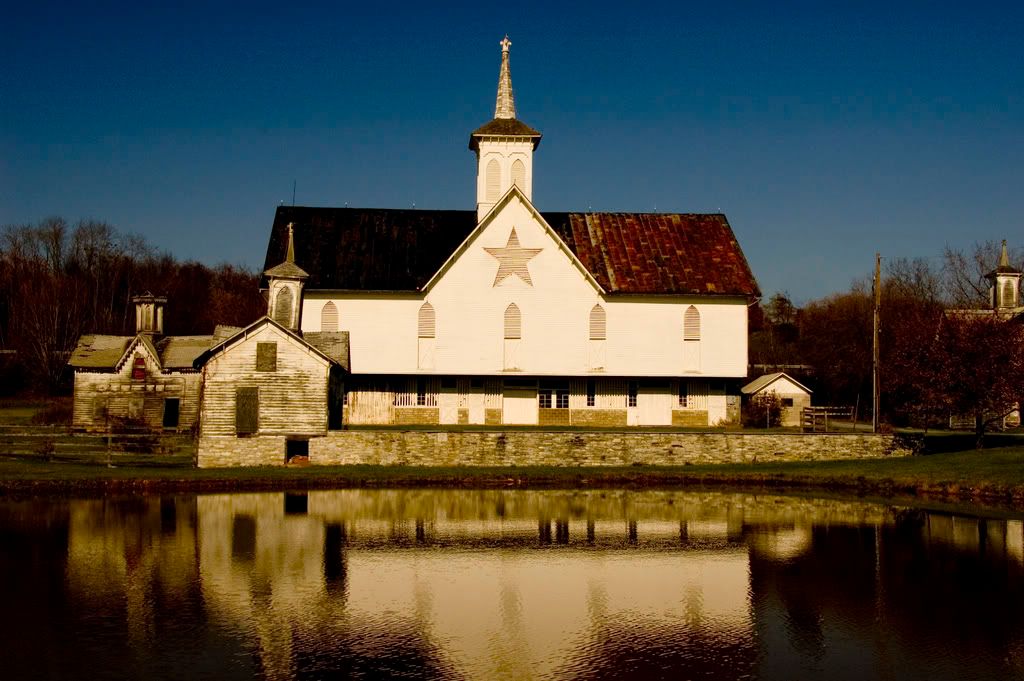Barnstar (Wikipedia)
A barnstar (or barn star, primitive star, or Pennsylvania star) is a decorative painted object or image, often in the shape of a five-pointed star but occasionally in a circular "wagon wheel" style, used to adorn a barn. They have no structural purpose, but may be considered lucky, akin to a horseshoe mounted over a doorway. They are especially common in Pennsylvania and frequently seen in German-American farming communities.
History
Barnstars were meant to represent the mark of the builder, but became more frequently used for aesthetic purposes and were added to the building after construction was complete. Enthusiasts have traced a number of wooden barnstars to individual builders in the Pennsylvania area, where numerous examples can still be seen.

Barnstars were used in the United States during the 18th century and as late as 1870 in Pennsylvania, where their popularity increased greatly following the Civil War. Their regular use preceded that time, however, and stars were commonplace on large buildings, particularly factories, in pre-war Richmond, Virginia.[1]
Barnstars remain a very popular form of decoration and modern houses are sometimes decorated with simple, metal, five-pointed stars which the makers describe as "barn-stars". They are often deliberately distressed or rusted, alluding to the traditional decoration.
If you connected the barnstar with the hex signs within Pennsylvania Dutch culture, then you are correct. All of this has an origin in pre-Christian German magical societies and Heathenry, but later revived into Christian society... just as Guido von List described. The above link continues...
Other star-shaped plates
On older buildings in the Pennsylvania Dutch area of the United States it is still possible to find barnstar-like building adornments which are painted, rather than wooden or metal, known as hex signs. Strictly speaking, they are defined apart from barnstars and visually bear only passing resemblance, but the two are often confused and their names are even regarded as interchangeable.[1] Some hex signs incorporate star shapes, while others may take the form of a rosette or contain pictures of birds and other animals.[5]
The term barnstar has been incorrectly applied to star-shaped anchor plates that are used for structural reinforcement, particularly on masonry buildings from the 18th and 19th centuries. These are made of cast iron and are used as tie plates serving as the washers for tie rods. The tie-rod-and-plate assembly serves to brace the masonry wall against tilting or lateral bowing.
Some Wiki-based communities give their users an award called a "barnstar", as a continuation of the "barn raising" metaphor. This originated on MeatballWiki. The image that is frequently used for this purpose is actually a photo of one of the structural tie plates described above, not of a barnstar proper.
Pow-wow (folk magic) [Wikipedia]
Pow-wow, called Braucherei in Deitsch, is a system of American folk religion and magic associated with the Pennsylvania Dutch.
"Hexerei" is the German magical-spiritual tradition; but "Braucherei or Speilwerk" is heavily tied to Christian practice. This sounds very suspiciously like... "permission from daddy"... to play with magic. A little modern reminder and leftover from the "burning times." There are, of course, examples of this from all Christian societies. The above link goes into much greater detail and history.
There have been many complex underground pagan traditions tied to Christian cultures, "hiding in plain sight," and not just German or European. I fully understand the power in symbolism of this.. and how it has become so habit forming over the centuries. The pagan spirit has become so institutionalized within Christianity! I recall a news article from earlier this year, of a man in another country who was released from prison after a lengthy prison sentence. He was begging the authorities to "allow him to stay." That is "institutionalized."
Still, I understand. It's a fun and creative endeavor to craft symbolism within something. It draws upon a unique individual expression. The rural tradition of "Upper Michigan folk medicine," brought there originally by women from the Italian Alps, survives within a Catholic culture. Those women would, of course, say that they're good Catholics.
Pennsylvania Dutch Pow-wow (YouTube)
Powwow: Braucherei (YouTube)
.



No comments:
Post a Comment